RBSE Solutions for Class 6 Science Chapter 16 Light and Shadows are part of RBSE Solutions for Class 6 Science. Here we have given Rajasthan Board RBSE Class 6 Science Chapter 16 Light and Shadows.
| Board | RBSE |
| Textbook | SIERT, Rajasthan |
| Class | Class 6 |
| Subject | Science |
| Chapter | Chapter 16 |
| Chapter Name | Light and Shadows |
| Number of Questions Solved | 44 |
| Category | RBSE Solutions |
Rajasthan Board RBSE Class 6 Science Chapter 16 Light and Shadows
Intext Questions
Question 1.
Classify the following light source as natural or artificial sources in table 16.1 (Page 132)
Answer:
Table 16.1 Classification of Natural and Artificial sources of light
| Source of light | Natural Source | Artificial source |
| 1. Torch | — | ✓ |
| 2. Bulb | — | ✓ |
| 3. Sun | ✓ | ✗ |
| 4. Candle | — | ✓ |
| 5. Moon | ✓ | ✗ |
| 6. Stars | ✓ | ✗ |
Question 2.
What exactly are shadows? What are the requirements for their formation.
Answer:
When light falls on an opaque object, the image formed on the screen behind the opaque object is called as its shadow. A shadow always forms in the opposite direction of the source of light.
Activities
Activity – 1
1. Take three rectangular cardboard pieces of the same size. Punch a hole exactly in the middle of each of these three cardboard pieces.
Explanation – It is clear now that to make a shadow, a source of light and an opaque object are required.
2. Now place the cardboard pieces on a table in such a way that their holes will remain in a straight line.
3. Place a lighted candle or a glowing bulb in front of the first cardboard piece.
4. Try to see the light of the candle or the bulb from the hole of the third cardboard piece.
Question 1.
Is the light of the candle or bulb visible to you?
Answer:
Yes
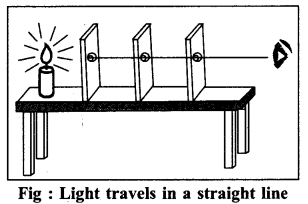
Now displace the second cardboard piece (move it a little leftwards or rightwards).
Question 2.
Is the light of the candle or bulb visible to you this time?
Answer:
No.
Question 3.
Why it is so?
Answer:
When all the three holes are in a straight line, then light reaches your eyes by travelling through them. But when the second cardboard piece is displaced by us then light is not able to pass through it and hence does not reach our eyes.
Activity – 2 (Page 133)
1. Take a piece of straight plastic pipe.
2. Light a candle and fix it on the table and from some distance try to see the candle through plastic pipe.
3. Now, standing at the other end of the room look at the candle through the pipe. You will be able to see it.
4. Bend the pipe a little and look at the candle again
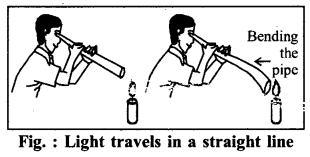
Question 1.
Are you still able to see the candle?
Answer:
No, on bending the pipe, the light stops at pipe walls. We can easily conclude from this activity that light travels in a straight path.
Activity – 3
Collect the objects used in everyday life like glass, textbook, cardboard, plate, spectacles etc. Try to look at a glowing electric bulb through all of these objects one by one.
Question 1.
Are you able to see the glowing bulb through all these objects?
Answer:
We are able to see the glowing bulb through glass and spectacles. You will find that there are some objects through which you can see and some objects through which you cannot see at all. Besides these, there are also some objects through which you can see, but not very clearly.
Activity – 4
Take a sheet of paper and see a glowing electric bulb through it.
Question 1.
Are you able to see the bulb clearly?
Answer:
No.
Drop some drops of cooking oil or melted butter at the center of the sheet of the paper and spread it. Try to see the glowing light bulb through the center of the paper sheet.
Question 2.
What do you see now?
Answer:
We can see the bulb partially.
Question 3.
Are you able to see the bulb more clearly now? But are you able to see other objects clearly from this oil dripped sheet of paper.
Answer:
Yes, we can see the bulb more clearly than previous. No, we are not able to see other objects clearly from the oil dipped sheet of paper.
Activity – 5
1. You can do this activity at night with your friends.
2. Light a candle and place it in a dark room. Make a shadow of your hand on a wall of the room.
3. Now remove hand back and hold a transparent glass sheet in front of the candle.
Question 1.
Can you see the shadow of the glass- sheet?
Answer:
No, the shadow is not formed. Blow the candle and try to see the shadow of your hand again. You will not be able to see the shadow of your hand this time.
Question 2.
Besides these, do we need any other thing.
Answer:
Yes, we also required a screen. Take a torch and a big cardboard sheet and go to an open field at night. Ask your friends to raise his hand at a place where there are no building, trees etc. behind him. Now throw light from your torch at your friend’s hand.
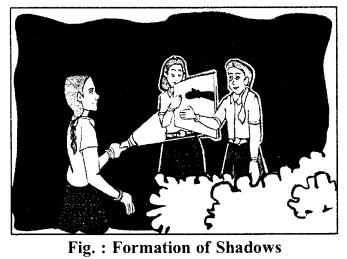
Question 3.
Now you have both a source of light and an opaque object in the path of the light, but are you able to see the shadow of your friend’s hand?
Answer:
No.
1. It does’t mean that there is no shadow at all behind your friend’s hand.
2. Ask your another friend to hold the cardboard sheet behind the hands of your friend.
Question 4.
Are you able to see the shadow of your friend’s hand this time?
Answer:
Yes, the shadow is formed on screen.
Explanation – We can conclude from this activity that a shadow is only obtained on a screen, floor, wall, ground, building and other similar things act as a screen for the shadows to form on.
Conclusion – It is clear now that for the formation of a shadow, a source of light, an opaque object in the path of light and a screen to obtain the shadow are the requirements.
Activity – 6 (Page 135)
1. Place a table near a wall in a dark room.
2. Stand a rectangular cardboard piece on the table.
3. Throw light on the cardboard piece by a torch.
4. Carefully observe the shadow formed on the wall.
Observation : You will observe that a dark shadow is formed on the wall. This dark shadow is called the antumbra. Around this dark shadow, you will observe a lighter shadow. This lighter shadow is called penumbra.
5. In the same way observe the antumbra and penumbra of a cricket ball and a football.
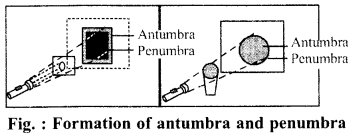
Exercises
Multiple Choice Questions
Question 1.
Which of the following is an opaque object?
(a) Glass
(b) Water
(c) Kerosene
(d) Wood
Answer:
(d) Wood
Question 2.
An artificial source of light is
(a) Sun
(b) Moon
(c) Candle
(d) Star
Answer:
(c) Candle
Question 3.
Lunar eclipse occurs on
(a) New moon night
(b) Full moon night
(c) First day of the month
(d) Second day of the month
Answer:
(b) Full moon night
Question 4.
Which of the following is required for the formation of shadows?
(a) Light source
(b) Opaque object
(c) Screen
(d) All of the above
Answer:
(d) All of the above
Fill in the blanks
1. Light travels in a ……….. line.
2. We can only see in the ……….. of light.
3. Lantern is a ……….. source of light.
4. Objects through which we cannot see are called ………. objects.
Answer:
1. straight
2. presence
3. artificial
4. opaque
Short Answer Type Questions
Question 1.
State the differences between transparent, opaque and translucent objects.
Answer:
The objects through which light can travel easily are called as transparent objects. The objects through which light cannot travel are called opaque objects. The objects through which light can travel partially are called trans hunt objects.
Question 2.
On which days a lunar and solar eclipse occurs?
Answer:
Lunar eclipse occurs on a full moon night while a solar eclipse occurs on a new moon night.
Question 3.
Draw a well labelled diagram of the event of a lunar eclipse.
Answer:
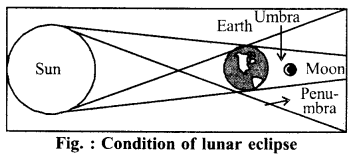
Question 4.
Write the reason for the formation of shadows.
Answer:
When light falls on an opaque object, the image formed on the screen behind the opaque object is called as its shadow. A shadow always forms in the opposite direction of the source of light.
Long Answer Type Questions
Question 1.
Explain through an activity that light travels on a straight line.
Answer:
- Take three rectangular cardboard pieces of the same size.
- Punch a hole exactly in the middle of each of these three cardboard pieces.
- Now place the cardboard pieces on a table in such a way that their holes will remain in a straight line.
- Place a lighted candle or a glowing bulb in front of the first cardboard piece.
- Try to see the light of the candle or the bulb from the hole of the third cardboard piece.
- Is the light of the candle or bulb visible to you?
- Yes.
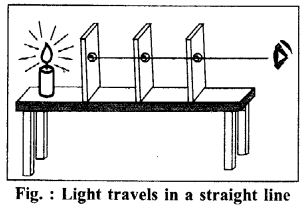
- Now displace the second cardboard piece (move it a little leftwards or rightwards).
- Is tire light of the candle or bulb visible to you?
- No.
- Why is it so?
- The above activity suggest that light travels in a straight path.
Question 2.
State the differences between antumbra and penumbra?
Answer:
When light falls on a opaque object, then a dark shadow forms on the screen. This dark shadow is called antumbra. A lighter shadow is formed around this dark shadow. This lights shadow is called penumbra.
Question 3.
Explain the event of a solar eclipse, Draw necessary diagrams.
Answer:
When moon comes between sun and earth, a solar eclipse occurs. When moon comes in between sun and earth while revolving around the earth then the shadow of moon falls on the earth and for that time we are not able to see the sun. This event is known as a solar eclipse.
Some part of the earth gets covered by the antumbra and some by the penumbra of moon. The part covered by the antumbra of moon observes complete solar eclipse while the part covered by penumbra observes fractional solar eclipse. At the time of complete solar eclipse, the outer edge of the sun is visible around the moon as a ring and is called the disc of sun.
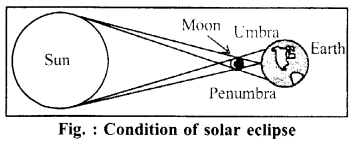
Practical Work
Question 1.
Classify different objects according to their transparency.
Answer:
Apparatus required : Mirror, glass (smooth/ rough), textbook, bulb, glass tumbler, earthen pot, plastic scale, spectacles, ball, polythene bag, thin sheet of paper, oil dripped sheet of paper, etc.
Activity – Keep these objects in front of your eyes one by one and try to see a glowing bulb through them.
Classify these objects in the following table:
| Nature of the Objects | Properties | Name of the objects |
| 1. Transparent | The objects through which light can travel easily and through which the glowing bulb is visible. | Glass, bulb, spectacle, air, clean water etc. |
| 2. Translucent | The objects through which light can travel partially and through which the glowing bulb was not clearly visible. | Oil dripped water, butter paper, tracing paper, rough glass. |
| 3. Opaque | The objects through which light cannot travel and through which the glowing bulb was not visible. | Metals, Wood, Cardboard stones etc. |
Other Important Questions
Multiple choice Questions
Question 1 .
The luminating body is
(a) Deepak
(b) Electric bulb
(c) Star
(d) Candle
Answer:
(c) Star
Question 2.
Moon glow due to
(a) Self light
(b) Light of sun
(c) Due to earth
(d) None of above
Answer:
(b) Light of sun
Question 3.
Transparent object is
(a) Glass
(b) Air
(c) Pure Water
(d) All of the above
Answer:
(d) All of the above
Question 4.
Translucent object is
(a) Light glass
(b) Dirty water
(c) Butter paper
(d) All of the above
Answer:
(d) All of the above
Question 5.
Solar eclipse falls on
(a) New moon night
(b) New moon day
(c) Night of full moon
(d) Day of full moon
Answer:
(a) New moon night
Fill in the blanks
1. To see an object we require ………. .
2. The greatest source of light is ………… .
3. Light always travel in ………….. .
4. Glass, air, pure water are …………. objects.
Answer:
1. Light
2. Sun
3. Straight line
4. Transparent
Very Short Answer Questions
Question 1.
How we can see objects?
Answer:
When light falls on an object, it reflects back to our eyes, pad only then we are able to see the object.
Question 2.
Write names of the illuminating objects.
Answer:
- Sun
- Bulb.
Question 3.
Write name of two artificial sources of light
Answer:
- Candle
- Kerosene lamp.
Question 4.
How is the path of light?
Answer:
Straight line.
Question 5.
Write names of two opaque objects.
Answer:
- Cardboard
- Sheet of tin
Short Answer Type Questions
Question 1.
Write some sources of light.
Answer:
- Sun
- Moon
- Electric bulb
- Lantern
- Candle
- C.F.L
- Tube light
- LED light.
Question 2.
Define the following
1. Luminous objects
2. Shadows.
Answer:
1. Luminous Objects – Objects like the sun that emit their own light are called luminous objects.
2. Shadow – When light falls on an opaque object, the image formed on the screen behind the opaque object is called as its shadow.
Question 3.
Explain the event of a lunar eclipse.
Answer:
When the moon while revolving around the earth falls under the shadow of the earth then this event is called as lunar eclipse. In other words, when earth comes in between the moon and sun, a lunar eclipse occurs.
Long Answer Type Questions
Question 1.
Explain transparent opaque and Translucent object with examples.
Answer:
Transparent Object – Objects through which light can travel without any obstruction and through which we can see objects are called as transparent objects.
Examples – Glass, air, clean water, some types of plastics etc.
Opaque Object – The objects through which light cannot travel at all and through which we are not able to see objects are called as opaque objects.
Examples – Metals, wood, cardboard, stones etc.
Translucent object – Objects which allow light to travel partially through them and through which we are not able to see them clearly are called as translucent object.
Examples – Oil dripped paper, butter paper, tracing paper, rough glass, etc.
We hope the RBSE Solutions for Class 6 Science Chapter 16 Light and Shadows will help you. If you have any query regarding Rajasthan Board RBSE Class 6 Science Chapter 16 Light and Shadows, drop a comment below and we will get back to you at the earliest.